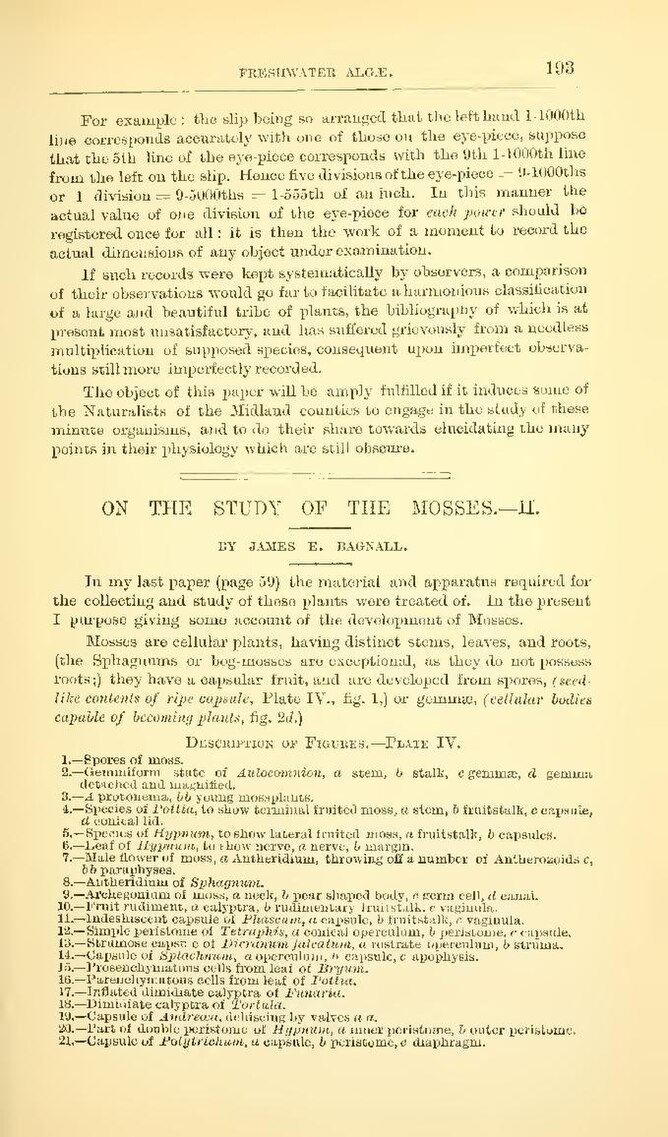For example: the slip being so arranged that the left hand 1-100th line corresponds accurately with one of those on the eyepiece, suppose that the 5th line of the eye-piece corresponds with the 9th 1-1000th line from the left on the slip. Hence five divisions of the eye-piece = 9-1000ths or 1 division = 9-500ths = 1-555th of an inch. In this manner the actual value of one division of the eye-piece for each power should he registered once for all: it is then the work of a moment to record the actual dimensions of any object under examination.
If such records were kept systematically by observers, a comparison of their observations would go far to facilitate a harmonious classification of a huge and beautiful tribe of plants, the bibliography of which is at present most unsatisfactory, and has suffered grievously from a needless multiplication of supposed species, consequent upon imperfect observations still more imperfectly recorded.
The object of this paper will he amply fulfilled if it induces some of the Naturalists of the Midland counties to engage in the study of these minute organisms, and to do their share towards elucidating the many points in their physiology which are still obscure.
On the Study of the Mosses.—II.
By James E. Bagnall.
In my last paper (page 59) the material and apparatus required for the collecting and study of these plants were treated of. In the present I purpose giving some account of the development of Mosses.
Mosses are cellular plants, having distinct stems, leaves, and roots, the Sphagnums or bog-mosses are exceptional, as they do not possess roots;) they have a capsular fruit, and are developed from spores, (seed-like contents of ripe capsule, Plate IV., fig. 1.) or geminæ, (cellular bodies capable of becoming plants, fig. 2d.)
Description of Figures.—Plate IV.
1.—Spores of moss. 2—Geminiform state of Auloconuion, a stem, b stalk, c gemma, d gemma detiched and washitied, 3.—A prytouema, bb young Mobs pluts. . 4.—Species of Pottia, to show ternal fruited moss, a stem, b fruitstalk, c capynie, d conical lid. 5,—Speaes af Ayparn, to show lateral frnited moss, 2 fruitstalk, b capsules. B—Leaf of type, Lu chow nerve, a nerve, b margin. 7.—Mule flower of moss, a Antheridium, throwing off a uumbcxr of Antheroucids c, bb paraphyses. 8.—Autheridinix of Sphagraem. 9—Archegonim of woss, a nek, b pear shaped buly, c germ cell, f eam. 10.—L'rnit rudiment, 2 calyptra, 6 rudimentary Jouitstilk. c vicgiuula. 11—lndeshiscent capsule ut Phascem, a capsule, b trnitstadk, c vaginula. 12.—Simple peristome of Tetraphts, a conical operculom, b perisbome, c cupartle, 13.—Strumose eapsn cof Micranwm jalcatwu, a vistrate wpecenlum, b struma. 14.—Capsule of Splechwum, a operenlijn, b capsule, c apophysis. 15.—Vroesenchyluatons eis from leai ot Bray. 16.—Purenelryn:ntous eclls irom lent of Poti, 17.—Influted dimidiate calyptra of Bvanarice. 18.—Diminiate calpptra of Lortelet. 19.—Capsule of dundrewe, deliscing by valves a 20.—Vart of double poristome of Ayres, & saner poristome, & outer perisluiue, 21.—Capisule of Polyirichuot, c capsule, b peristeme, c diaphragm.
